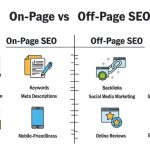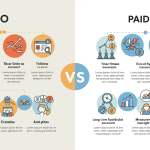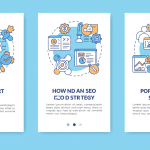
Search engine optimization can feel overwhelming, but it doesn’t have to be. With the right strategies and a clear understanding of how search engines work, you can dramatically improve your website’s visibility and drive more organic traffic to your business.
Why Website SEO Matters More Than Ever
Website SEO encompasses all the techniques and strategies used to improve your site’s visibility in search engine results. At its core, SEO helps search engines understand your content and determines how well your pages should rank for relevant queries.
Modern SEO involves three main components: technical optimization, content creation, and authority building. Each element plays a crucial role in your overall search performance, and neglecting any one area can limit your success.
The landscape has evolved significantly over the past decade. Early SEO focused heavily on keyword density and link quantity. Today’s SEO emphasizes user experience, content quality, and meeting search intent. Google’s algorithm updates have consistently moved toward rewarding sites that provide genuine value to users.
Technical SEO: Building Your Foundation
Technical SEO ensures search engines can effectively crawl, index, and understand your website. Poor technical SEO can prevent even the best content from ranking well, making it your first priority.
Optimizing Website Speed and Performance
Page speed directly impacts both user experience and search rankings. Google considers page speed a ranking factor, and slow-loading pages often have higher bounce rates.
Key performance optimizations include compressing images and using modern formats like WebP, minimizing HTTP requests through file combination, and leveraging browser caching for static resources. Using a content delivery network (CDN) and optimizing server response times can also dramatically improve load times.
Tools like Google PageSpeed Insights and GTmetrix help identify specific performance issues and provide actionable recommendations. Aim for loading times under three seconds, as this is where most users expect pages to load.
Mobile-First Optimization
Google uses mobile-first indexing, meaning it primarily uses the mobile version of your site for ranking and indexing. Your mobile experience must be excellent for SEO success.
Mobile optimization includes responsive design that adapts to different screen sizes, fast loading times on mobile devices, and easy navigation with touch-friendly elements. Ensure text is readable without zooming and that buttons and links are properly sized for mobile interaction.
Test your site regularly on different devices and screen sizes. What looks perfect on desktop might be frustrating on mobile, and search engines will notice the difference.
Site Architecture and Navigation
Clean site architecture helps search engines understand your content hierarchy and helps users find information easily. Well-structured sites typically rank better than poorly organized ones.
Best practices include creating a logical URL structure with descriptive paths, implementing internal linking that connects related content, and using XML sitemaps that guide search engine crawling. Breadcrumb navigation improves user experience, while strategic use of header tags (H1, H2, H3) helps search engines understand content hierarchy.
Schema Markup Implementation
Schema markup provides additional context about your content to search engines. This structured data can improve how your pages appear in search results through rich snippets, potentially increasing click-through rates.
Common schema types include article markup for blog posts and news content, local business markup for location-based businesses, and product markup for e-commerce sites. Review markup for customer testimonials and FAQ markup for question-and-answer content can also enhance your search appearance.
Content Optimization Strategies

Content remains the foundation of successful SEO. High-quality, relevant content attracts both search engines and users, driving organic traffic and engagement.
Keyword Research and Strategy
Effective keyword research goes beyond finding high-volume terms. Modern keyword strategy focuses on understanding user intent and creating content that satisfies specific needs.
Start by identifying seed keywords related to your business, then use tools like Google Keyword Planner, SEMrush, or Ahrefs to expand your list. Analyze search intent behind different keywords—are users looking for information, trying to make a purchase, or seeking a specific website?
Target a mix of short-tail and long-tail keywords. Long-tail keywords often have lower competition and higher conversion rates because they represent more specific search intent. For example, “running shoes” is highly competitive, while “best running shoes for flat feet women” is more specific and easier to rank for.
Creating SEO-Friendly Content
Creating SEO-friendly content requires balancing search optimization with user value. Content should be comprehensive, well-researched, and genuinely helpful to your audience.
Key content optimization elements include compelling headlines that include target keywords, meta descriptions that encourage clicks, and proper header tag structure. Integrate keywords naturally throughout the content, include internal links to related pages, and add external links to authoritative sources when relevant.
Content Depth and Comprehensiveness
Search engines favor comprehensive content that thoroughly covers topics. Longer-form content often ranks better than short, surface-level pieces, but length alone isn’t enough—depth and quality matter more.
Comprehensive content includes multiple subtopics related to the main theme, detailed explanations and examples, and visual elements like images, charts, and videos. Answer common questions your audience might have and provide actionable takeaways they can implement.
Keeping Content Fresh and Updated
Regularly updating content signals to search engines that your site is active and current. Some topics benefit from frequent updates, while evergreen content may only need periodic refreshing.
Update strategies include adding new information to existing articles, refreshing statistics and data, and improving content based on user feedback. Expand successful content with additional details and remove or update outdated information that might confuse readers.
On-Page SEO Optimization
On-page SEO involves optimizing individual web pages to rank higher and earn more relevant traffic. This includes both visible content and HTML source code optimization.
Title Tag Optimization
Title tags are one of the most important on-page SEO elements. They appear in search results and browser tabs, significantly impacting click-through rates.
Effective title tags include primary keywords near the beginning, stay under 60 characters to avoid truncation, and accurately describe the page content. Use compelling language that encourages clicks and create unique titles for each page.
Meta Description Best Practices
Meta descriptions don’t directly impact rankings but influence click-through rates from search results. Well-written descriptions can significantly improve organic traffic.
Keep descriptions between 150-160 characters, include primary keywords naturally, and write compelling copy that encourages clicks. Accurately summarize the page content and include a call-to-action when appropriate.
Header Tag Structure
Proper header tag usage helps search engines understand content hierarchy and improves user experience. Headers also provide natural opportunities for keyword inclusion.
Use only one H1 tag per page, include primary keywords in H1 and H2 tags, and maintain logical hierarchy (H1 > H2 > H3). Use headers to break up long content and write descriptive, keyword-rich headers that guide readers through your content.
Internal Linking Strategy
Internal links help search engines discover new content and understand site structure. They also distribute page authority throughout your site and improve user navigation.
Link to relevant, related content using descriptive anchor text. Include internal links naturally within content, create topic clusters around pillar content, and regularly audit and update internal links to ensure they remain relevant and functional.
Off-Page SEO and Link Building
Off-page SEO focuses on activities outside your website that impact search rankings. Link building remains a crucial component of off-page SEO.
Understanding Link Authority
Not all links are created equal. Search engines evaluate link quality based on the linking site’s authority, relevance, and trustworthiness. One high-quality link can be more valuable than dozens of low-quality links.
Quality link characteristics include links from authoritative, established websites, relevant anchor text that describes the linked content, and links from sites in related industries or topics. Editorial links earned through valuable content and links from pages with high page authority carry more weight.
Effective Link Building Strategies
Effective link building requires creating valuable content and building relationships within your industry. Focus on earning links naturally rather than pursuing manipulative tactics.
Proven link building methods include creating linkable assets like research studies and infographics, guest posting on relevant, high-authority sites, and building relationships with industry influencers. Participate in industry events and conferences, and create tools and resources that others want to reference.
Local SEO and Citations
For businesses serving local customers, local SEO is crucial. Local SEO focuses on optimizing for location-based searches and improving visibility in local search results.
Local SEO components include Google My Business optimization, consistent NAP (Name, Address, Phone) information, and local citation building across directories. Manage customer reviews actively and create location-specific content that serves your local audience.
Measuring SEO Success
Effective SEO requires continuous monitoring and analysis. Understanding key metrics helps you identify successful strategies and areas for improvement.
Essential SEO Metrics
Track metrics that directly relate to your business goals. Rankings are important, but traffic and conversions matter more for business success.
Key metrics include organic traffic growth, keyword ranking improvements, and click-through rates from search results. Monitor bounce rates and user engagement, as well as conversion rates from organic traffic to understand the quality of your SEO efforts.
SEO Tools and Analytics

Various tools help monitor SEO performance and identify optimization opportunities. Combine multiple tools for comprehensive analysis.
Google Analytics provides traffic and behavior analysis, while Google Search Console offers search performance data. SEMrush or Ahrefs help with keyword research and competitor analysis. Screaming Frog assists with technical SEO audits, and PageSpeed Insights helps optimize performance.
Your Next Steps in SEO
SEO success doesn’t happen overnight, but with consistent effort and the right strategies, you can significantly improve your website’s search visibility. Start with technical SEO to ensure your foundation is solid, then focus on creating valuable content that serves your audience’s needs.
Remember that SEO is an ongoing process that requires constant attention and refinement. Search engines continuously update their algorithms, and your competitors are always working to improve their rankings. Stay informed about industry changes, monitor your performance regularly, and adjust your strategies based on what the data tells you.
Begin by conducting a comprehensive audit of your current SEO efforts. Identify quick wins you can implement immediately, then develop a long-term strategy that aligns with your business goals. The investment in SEO will pay dividends for years to come through increased organic traffic and improved online visibility.


















No Comments